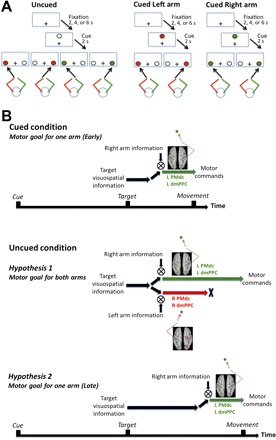Fig. 1.

A: task description. Subjects performed reaching movements with their left or right index fingertips toward colored targets presented either left or right of a central fixation point (depicted as “+”). The color of the target instructed which arm to use for the reach (e.g., red target = left arm, green target = right arm). Before each target presentation, a cue was provided for 2 s, the color of which was either noninformative (white; uncued condition) or fully informative (red or green; cued condition) as to the color of the upcoming target, and therefore the arm to be used. B: hypotheses. Top: cued condition: early specification of a motor goal for a single arm in contralateral dorsomedial posterior parietal cortex (dmPPC) and caudal part of the dorsal premotor cortex (PMdc). When subjects know which arm to use before target onset, the target and arm sensory signals are rapidly integrated in the contralateral dmPPC and PMdc to form a motor goal (Beurze et al. 2007; Chang et al. 2008). We assume that the cued condition incurs negligible specification of a motor goal for the “unselected” arm (i.e., ipsilateral dmPPC and PMdc). Middle: uncued condition, hypothesis 1: specification of motor goals for both arms in bilateral dmPPC and PMdc. A first possibility is that effector selection is associated with the parallel encoding of motor goals tied to the 2 arms in bilateral dmPPC and PMdc, until 1 is selected for overt execution. This predicts greater activity in dmPPC and PMdc controlling the unselected arm (i.e., ipsilateral dmPPC and PMdc) in the uncued compared with the cued condition. Bottom: uncued condition, hypothesis 2: late specification of a motor goal for a single arm in contralateral dmPPC and PMdc. A second possibility is that dmPPC and PMdc do not contribute to effector selection but are only recruited to form a motor goal after an arm is selected. This predicts a delay in the recruitment of contralateral dmPPC and PMdc in the uncued compared with the cued condition.
